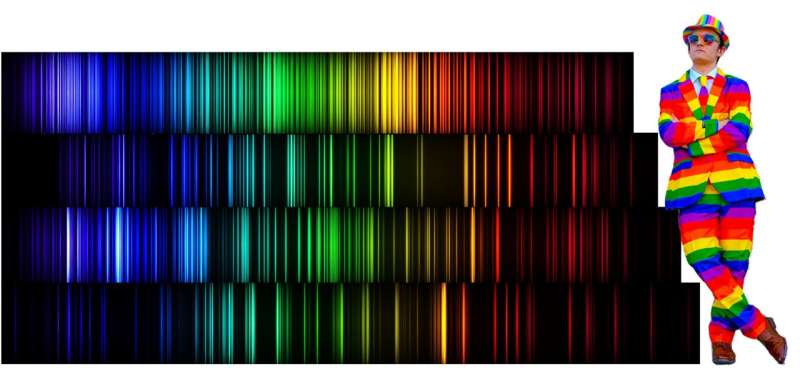This article has been reviewed according to Science X's editorial process and policies. Editors have highlighted the following attributes while ensuring the content's credibility:
fact-checked
trusted source
proofread
What do the elements sound like?

In chemistry, we have He, Fe and Ca—but what about do, re and mi? Hauntingly beautiful melodies aren't the first things that come to mind when looking at the periodic table of the elements. However, using a technique called data sonification, a recent college graduate has converted the visible light given off by the elements into audio, creating unique, complex sounds for each one. Today, the researcher reports the first step toward an interactive, musical periodic table.
The researcher will present his results at the spring meeting of the American Chemical Society (ACS). ACS Spring 2023 is a hybrid meeting being held virtually and in-person March 26–30.
Previously, W. Walker Smith, the project's sole investigator, took his combined passions of music and chemistry and converted the natural vibrations of molecules into a musical composition. "Then I saw visual representations of the discrete wavelengths of light released by the elements, such as scandium," says Smith. "They were gorgeous and complex, and I thought, 'Wow, I really want to turn these into music, too.'"
Elements emit visible light when they are energized. This light is made up of multiple individual wavelengths, or particular colors, with brightness levels that are unique for each element. But on paper, the collections of wavelengths for different elements are hard to tell apart visually, especially for the transition metals, which can have thousands of individual colors, says Smith. Converting the light into sound frequencies could be another way for people to detect the differences between elements.
However, creating sounds for the elements on the periodic table has been done before. For instance, other scientists have assigned the brightest wavelengths to single notes played by the keys on a traditional piano. But this approach reduced the rich variety of wavelengths released by some elements into just a few sounds, explains Smith, who is currently a researcher at Indiana University.
To retain as much of the complexity and nuance of the element spectra as possible, Smith consulted faculty mentors at Indiana University, including David Clemmer, Ph.D., a professor in the chemistry department, and Chi Wang, D.M.A., a professor in the Jacobs School of Music. With their assistance, Smith built a computer code for real-time audio that converted each element's light data into mixtures of notes. The discrete color wavelengths became individual sine waves whose frequency corresponded to that of the light, and their amplitude matched the brightness of the light.
Early in the research process, Clemmer and Smith discussed the pattern similarities between light and sound vibrations. For instance, within the colors of visible light, violet has almost double the frequency of red, and in music, one doubling of frequency corresponds to an octave. Therefore, visible light can be thought of as an "octave of light." But this octave of light is at a much higher frequency than the audible range. So, Smith scaled the sine waves' frequencies down by approximately 10-12, fitting the audio output into a range where human ears are most sensitive to differences in pitch.
Because some elements had hundreds or thousands of frequencies, the code allowed these notes to be generated in real time, forming harmonies and beating patterns as they mixed together. "The result is that the simpler elements, such as hydrogen and helium, sound vaguely like musical chords, but the rest have a more complex collection of sounds," says Smith. For example, calcium sounds like bells chiming together with a rhythm resulting from how the frequencies interact with each other. Listening to the notes from some other elements reminded Smith of a spooky background noise, similar to music used in cheesy horror movies. He was especially surprised by the element zinc, which despite having a large number of colors, sounded like "an angelic choir singing a major chord with vibrato."
"Some of the notes sound out of tune, but Smith has kept true to that in this translation of the elements into music," says Clemmer. These off-key tones—known musically as microtones—come from frequencies that are found between the keys of a traditional piano. Agreeing, Wang says, "The decisions as to what's vital to preserve when doing data sonification are both challenging and rewarding. And Smith did a great job making such decisions from a musical standpoint."
The next step is to turn this technology into a new musical instrument with an exhibit at the WonderLab Museum of Science, Health, and Technology in Bloomington, Indiana. "I want to create an interactive, real-time musical periodic table, which allows both children and adults to select an element and see a display of its visible light spectrum and hear it at the same time," says Smith. He adds that this sound-based approach has potential value as an alternative teaching method in chemistry classrooms, because it's inclusive to people with visual impairments and different learning styles.
On Tuesday, March 28, at 3:00 p.m., during the ACS Spring 2023 Meeting, Smith will also perform "The Sound of Molecules," a show that will feature audio clips of a few of the elements, as well as "compositions" of larger molecules.
More information: ACS Spring 2023: Designing an interactive musical periodic table: sonification of visible element emission spectra, www.acs.org/meetings/acs-meetings/spring-2023.html
Provided by American Chemical Society





















